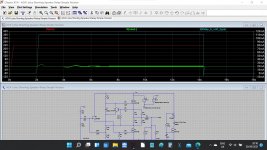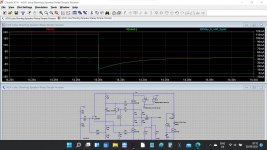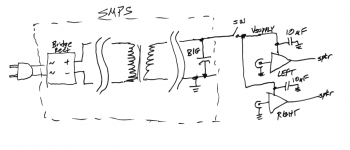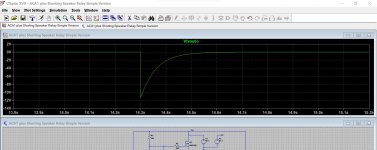It is all a bit of an unknown Mark but bear in mind the SMPS reservoir cap (primary side) will play a part as well. That will probably prolong the agony of the rail collapsing.
I do hear what you are saying though 🙂
Perhaps anyone interested could try and do a real world measurement of the rail with a suitable scope.
One easy clue could be... are you there all you ACA owners... is this:
Does the front panel LED go out immediately you power off or can you detect any very quick fade down of the brightness of it? Its a very empirical kind of a test but would be interesting.
I do hear what you are saying though 🙂
Perhaps anyone interested could try and do a real world measurement of the rail with a suitable scope.
One easy clue could be... are you there all you ACA owners... is this:
Does the front panel LED go out immediately you power off or can you detect any very quick fade down of the brightness of it? Its a very empirical kind of a test but would be interesting.
It is a fade down, but not very quick, about 1 second.
But there is a difference between separating the SMPS from the AC (no thump at all) and turning off the amp (thump is here).
But there is a difference between separating the SMPS from the AC (no thump at all) and turning off the amp (thump is here).
Last edited:
Interesting, thanks 🙂
I was thinking all along that the on/off switch was switching AC power but of course it is the DC rail only. My mistake on that.
So the simple circuit would prevent start up noise but would not prevent noise on powering down as the rail collapse using the ACA on/off switch would be instant. I see where you are coming from now Mark 🙂
So no super easy fix for that aspect of it unfortunately.
I was thinking all along that the on/off switch was switching AC power but of course it is the DC rail only. My mistake on that.
So the simple circuit would prevent start up noise but would not prevent noise on powering down as the rail collapse using the ACA on/off switch would be instant. I see where you are coming from now Mark 🙂
So no super easy fix for that aspect of it unfortunately.
My test could be invalid, if switching off the AC input to the supply makes it that way. I leave the panel switch on and use a power strip instead. You may also glean some useful information from that scenario as well… : )
^ If removing the AC power to the SMPS gives a fade out of the LED then the rail is falling more slowly and in that situation the simple idea could work on supressing power off noise.
It is when the rail collapses instantly that we might run into trouble. By the time the relay opens the noise may well have happened... although it would still be really interesting to try it for real. That large speaker coupling cap would take far longer to discharge than the relay drop out time would be. Maybe the noise is only just beginning as the rail hits zero.
It is when the rail collapses instantly that we might run into trouble. By the time the relay opens the noise may well have happened... although it would still be really interesting to try it for real. That large speaker coupling cap would take far longer to discharge than the relay drop out time would be. Maybe the noise is only just beginning as the rail hits zero.
I'll post this for interest. Here is the ACA with just 100mv audio (green trace). The red trace is the supply and the bluish one is the relay coil current.
You can see the supply disappear 15 seconds in (the ACA gets turned off). I've set the supply fall time to just 50 microseconds so its quick.
Notice the amplitude of the spike to the speaker. It dips to almost -12 volts as all the charge in the speaker coupling cap is pulled back through the speaker.
Second image is a close up of that transition. The relay current is reduced to zero quickly but I wonder how long a real relay would take to drop out.
One for another day... I have another idea as well that may or may not work or meet with approval.
You can see the supply disappear 15 seconds in (the ACA gets turned off). I've set the supply fall time to just 50 microseconds so its quick.
Notice the amplitude of the spike to the speaker. It dips to almost -12 volts as all the charge in the speaker coupling cap is pulled back through the speaker.
Second image is a close up of that transition. The relay current is reduced to zero quickly but I wonder how long a real relay would take to drop out.
One for another day... I have another idea as well that may or may not work or meet with approval.
Attachments
Starting about 20 minutes ago my B side sounds like it’s playing through a narrow can. Sound is coming through and I can adjust the volume but it has lost crispness and just has a dead flat sound. I did switch speakers and took the pre amp out and the problem stays with the B side.
I’m getting out the docs and going to start measuring everything, but if anyone has any suggestions please let me know.
I’m getting out the docs and going to start measuring everything, but if anyone has any suggestions please let me know.
No LED fade with AC removal. Instant “lights out”
A slight thump in the speakers. They’ve been thumping, daily for a few years now and not hurt a thing. I drive a set of Emotiva T2 speakers with each mono block in Parallel configuration. So wonder in your quest, if the lower impedance speakers also play into how quickly the amp energy gets absorbed on shutdown. It might take more time to dissipate the thump if the load at whatever frequency the thump is: is 18 or 20 ohms as opposed to 3 or 4 ohms.
A slight thump in the speakers. They’ve been thumping, daily for a few years now and not hurt a thing. I drive a set of Emotiva T2 speakers with each mono block in Parallel configuration. So wonder in your quest, if the lower impedance speakers also play into how quickly the amp energy gets absorbed on shutdown. It might take more time to dissipate the thump if the load at whatever frequency the thump is: is 18 or 20 ohms as opposed to 3 or 4 ohms.
The amp output (positive terminal of the 3300 uF output coupling capacitor) instantly falls from +12V to GND. The negative terminal of the output cap follows the positive terminal {that's what caps do}, and instantly falls from GND to -12V. Since the negative side of the output cap is connected to the loudspeaker, the loudspeaker reproduces this 12 volt step-down waveform. It issues a pop sound.
Here's a picture showing why the SMPS caps are unimportant when the front panel switch changes from on to off.
_
Here's a picture showing why the SMPS caps are unimportant when the front panel switch changes from on to off.
_
Attachments
Rule #1. Don’t panic.
Rule #2. Check the speaker wire connection at the speaker also!
It did give me a chance to tweak the DC balance while I was in there.
Rule #2. Check the speaker wire connection at the speaker also!
It did give me a chance to tweak the DC balance while I was in there.
Starting about 20 minutes ago my B side sounds like it’s playing through a narrow can. Sound is coming through and I can adjust the volume but it has lost crispness and just has a dead flat sound. I did switch speakers and took the pre amp out and the problem stays with the B side.
I’m getting out the docs and going to start measuring everything, but if anyone has any suggestions please let me know.
excuse my chiming in here but you guys seems to be on top of ACA PSU's so felt you'd be good for an answer I'm chasing.
I'm building an F5, I have its 24vDC PSU already built - sort of a module build so it just drops straight into the F5 chassis on a sub chassis. Anyway my question is, can I safely run my ACA off this F5 PSU just for curiosity sake?
Thanks Allan
I'm building an F5, I have its 24vDC PSU already built - sort of a module build so it just drops straight into the F5 chassis on a sub chassis. Anyway my question is, can I safely run my ACA off this F5 PSU just for curiosity sake?
Thanks Allan
Last edited:
Here's a picture showing why the SMPS caps are unimportant when the front panel switch changes from on to off.
_
Thanks Mark, we must have posted simultaneously as I never spotted your post.
For some reason (probably that I've never built one 🙂) I had it that the ACA switch was disconnecting the AC supply and not switching just the 24v rail.
Of course that essentially means the rail collapses near instantly. I do have an idea but it would be a bit more complex and would mean a small PCB within the ACA. And it may just stay an idea 😉
FWIW, i never switched dc supply where currents are huge, instead i switch the smps primary where currents are really small, 6amp rating for switch contacts are indeed more than enough for a current that run about 50ma on a 230vac line...
I noticed when I power on my ACA, I get a faint groan from my speakers... almost like a stomach growling. Anyone else notice this? Nothing to worry about right?
Do you, or anyone have a part#, link or specs for one of these metal illuminated power switch? Seems like this would be a relatively simple change that would upgrade the fit and feel.
Thanks!
Thanks!
I had the same idea for my ACA which I just finished to build.
This LED switch (19mm diameter type) is easy to install and fits perfectly. It has a nice feel for switching on/off, and it provides a beautiful look to this little amp.
Two terminals are used for the incoming V+ from the external power supply and the V+ going to the pcb’s (this is similar to the stock front switch of the ACA). Then a 10k resistor can be connected between the V+ terminal (which is wired to the pcb) and the LED terminal. The 2nd LED terminal is wired to the ground bus at the back of the amplifier. The LED will turn on at the same time as the amplifier.
An affordable and simple upgrade with a nice result as you can see below 🙂
- Home
- Amplifiers
- Pass Labs
- Amp Camp Amp - ACA



